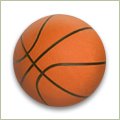
Under the basket, players are pushing and shoving for position to rebound a shot that’s just gone up. The ball hits the rim, bounces out and….. WHAM!!
Someone gets hit in the mouth with an elbow.
The referee blows his whistle and play comes to a stop while the trainer and coach runs out onto the floor to check on the player, hands held over bloody mouth, looking down on the floor for the tooth that’s been knocked out.
According to the American Dental Association an athlete is 60 times more likely to suffer harm to the teeth when not wearing a mouthguard. Since 80% of traumatic dental injuries occur to your top front teeth, mouthguards are important for athletes who don’t want to look like Leon Spinks or Bobbie Clarke. And for those of you who think this only relates to boxers and hockey players, studies have shown that basketball dental injuries are now 13 times higher than football (probably because high school football players have been required to wear mouthguards since the 1960’s).
According to the American Dental Association an athlete is 60 times more likely to suffer harm to the teeth when not wearing a mouthguard. Since 80% of traumatic dental injuries occur to your top front teeth, mouthguards are important for athletes who don’t want to look like Leon Spinks or Bobbie Clarke. And for those of you who think this only relates to boxers and hockey players, studies have shown that basketball dental injuries are now 13 times higher than football (probably because high school football players have been required to wear mouthguards since the 1960’s).
Mouthguards act as a layer over your top (“maxillary”) teeth to protect them from impacts that might break or crack them and protect your lips and tongue from cuts from your teeth or braces.
How much can wearing a mouthguard help you? A 2002 article found that college basketball players wearing custom mouthguards had only 1/3rd as many mouth injuries as players who did not.
So why don’t more basketball players make like Dee Brown and get their ‘guards’ on?
It’s probably a combination of several factors:
- While most football players consider mouthguards as part of their basic equipment, young basketball players often don’t get introduced to mouthguards until somebody (they or their teammate) gets hurt.
- Most basketball coaches (and leagues) don’t require their players to wear mouthguards and don’t teach their players about them.
- Not many players know that mouthguards will help prevent injuries, and even those who do may not actually wear them. A 2003 study of Australian basketball players found that only 30% of them were aware of mouthguards as protective devices and less than 2% actually wore one.
- Mouthguards that don’t fit well can make it hard to breath and communicate, two important parts of playing basketball.
- Even when they fit well, mouthguards take some getting used to, so the earlier a player starts with a mouthguard, the more likely they’ll feel it’s part of their basketball gear.
That said, the evidence points to the need for the youth basketball community, including parents, coaches and league officials, to consider mandating mouthguard use in both boys' and girls' basketball. As the game becomes even more physical, we are likely to see more dental injuries. We know they reduce the risk of injury, now we just have to increase knowledge about them and access to them.
In my next blog entry, I’ll cover the advantages and disadvantages of the 3 most common types of mouthguards and talk about how you can tell when you’re wearing the right kind so that you can show off your moves, and all your pearly whites, on the court.
In my next blog entry, I’ll cover the advantages and disadvantages of the 3 most common types of mouthguards and talk about how you can tell when you’re wearing the right kind so that you can show off your moves, and all your pearly whites, on the court.








No comments:
Post a Comment